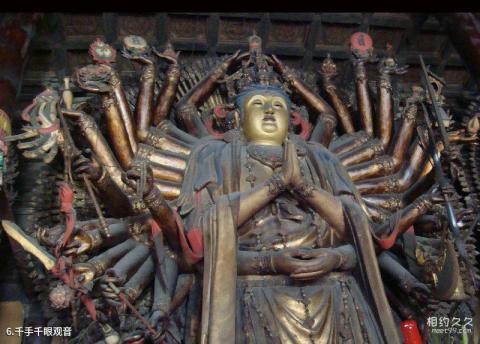
Introduction to Avalokitesvara with Thousand Arms and Thousand Eyes: On the Xumizuo in front of the hall, three clay statues of gilded Bodhisattvas stand side by side, with a height of 8.3 meters. The three Bodhisattvas are Avalokitesvara, Manjusri, and Samantabhadra, who are called the "Three Great Masters" among the Bodhisattvas. The three statues have moderate proportions, solemn appearance, strong body, comfortable appearance, gorgeous clothing and smooth clothing lines. They have a kind of gentle, graceful, kind, amiable and respectable charm. They are the sculptures of the Ming Dynasty in China. A masterpiece of art. In the center of the Buddhist altar is the Thousand-Armed and Thousand-Eyed Avalokitesvara Bodhisattva. The Thousand-Armed and Thousand-Eyed Avalokitesvara in the Great Compassion Hall is one of the six images belonging to Tantra (a sect of Buddhism). This kind of statue is nominally called Thousand Hands and Thousand Eyes. In fact, it has 20 hands on the left and right, with one eye in each hand, for a total of 40 hands and 40 eyes. The environment in which sentient beings exist) is the Thousand Hands and Thousand Eyes. An eye on the forehead symbolizes that one has reached the "Samadhi realm" in practice; the eight kinds of magical objects in his hand, including wheel, conch, umbrella, building, flower, fish, bottle and knot, symbolize good luck; he holds a knife, gun, Swords and halberds are used to subjugate demons; the "sun" and "moon" held high in both hands symbolize the infinite Dharma that governs the universe; the hada on the chest symbolizes his devout respect for the Buddha. It can be said that the shape is unique and the imagination is rich.
